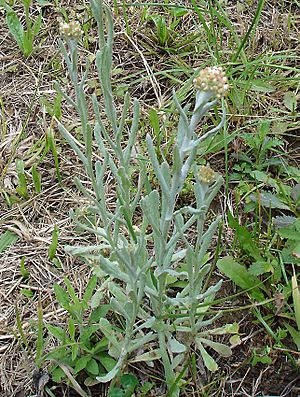Jersey cudweed facts for kids
Quick facts for kids Jersey cudweed |
|
|---|---|
 |
|
| Scientific classification | |
| Kingdom: | |
| (unranked): | |
| (unranked): | |
| (unranked): | |
| Order: | |
| Family: | |
| Genus: | |
| Species: |
H. luteoalbum
|
| Binomial name | |
| Helichrysum luteoalbum (L.) Rchb.
|
|
| Synonyms | |
|
Gnaphalium luteoalbum L. |
|
The Helichrysum luteoalbum, also known as the Jersey cudweed, is a type of flowering plant. It belongs to the daisy family, called Asteraceae.
What it Looks Like
This plant is a herbaceous plant, meaning it has soft stems, not woody ones. It can grow up to 70 cm (28 in) (about 27 inches) tall. Its stems branch out from the bottom.
The leaves are shaped like a spear or a spoon. They are covered in tiny hairs, much like the famous edelweiss flower. These leaves are tough and can even survive when frozen in winter.
The flowers of the Jersey cudweed can be different colors. You might see them in cream, yellow, white, or pink. The seeds have a special feathery part called a pappus. This pappus acts like a tiny parachute, helping the seeds float far away in the wind.
How it Got its Name
The Jersey cudweed has had a few different scientific names over the years. In 1753, a famous scientist named Carl Linnaeus first described this plant. He called it Gnaphalium luteo-album.
Later, in 1829, another scientist named Ludwig Reichenbach moved it to a different group, the Helichrysum genus. But for a long time, people kept calling it Gnaphalium.
Then, in 1981, it was moved again to the Pseudognaphalium group. Scientists use special studies to understand how plants are related. In 2004, new research showed that this plant actually fit best with the Helichrysum group. So, Reichenbach's old name for it was used again.
Where it Grows
This plant grows in so many places around the world that it's hard to know exactly where it first came from. Scientists believe it is native to almost every continent except Antarctica. This means it grew there naturally for a long time.
It is considered to have been brought to North America and South America by people. When a plant grows in a new place because humans brought it there, it's called "naturalized."
You can find the Jersey cudweed growing in meadows, empty lots, and at the edges of forests. Sometimes, its young leaves look a bit like the edelweiss plant, which can confuse people.
Uses of the Plant
In Vietnam, people use the Jersey cudweed as an ingredient in food. For example, it's used to make a type of rice cake called banh khuc.
It has also been used in traditional medicine in that region. People have used it to help with things like coughs, pain, and to reduce fever. It was also used as a diuretic (to help the body get rid of extra water) and a hemostatic (to help stop bleeding).
See also
 In Spanish: Pseudognaphalium luteoalbum para niños
In Spanish: Pseudognaphalium luteoalbum para niños

